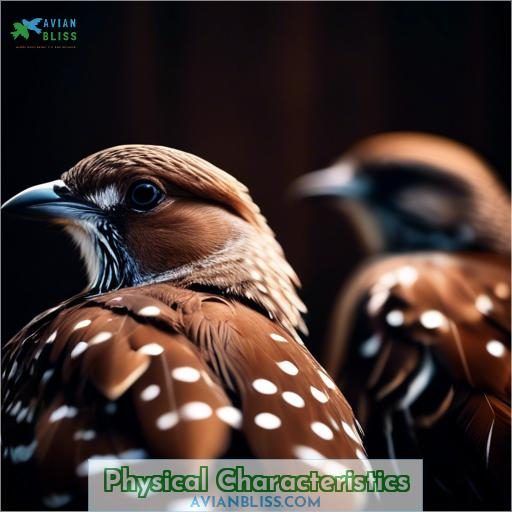This site is supported by our readers. We may earn a commission, at no cost to you, if you purchase through links.

You’re captivated by the striking contrast of rich brown feathers adorned with crisp white speckles.
These medium-sized birds, ranging from 9.1 to 11.8 inches long, often display aggressive and territorial behavior, especially during breeding season.
Their preferred habitat includes dense thickets, hedgerows, and woodland edges near water sources, where they construct bulky nests low in shrubs or trees.
Similar species with this distinctive plumage pattern include the Brown Thrasher, Northern Mockingbird, and Le Conte’s Thrasher.
To fully appreciate the unique characteristics and conservation efforts surrounding these feathered beauties, further exploration awaits.
Table Of Contents
Key Takeaways
- Brown birds with white spots are medium-sized birds with a length of 9.1 to 11.8 inches and a wingspan of 11.4 to 12.6 inches. They have a slender body, long legs, and a long, slightly downcurved bill.
- These birds are known for their aggressive and territorial behavior, especially during the breeding season. They build bulky nests in low shrubs or trees and feed insects, berries, and fruits to their young.
- Conservation efforts for these birds focus on protecting and restoring dense thickets and hedgerows, as they prefer habitats with these features. Their populations are currently stable or increasing, but they face threats from habitat loss and fragmentation.
- Brown birds with white spots are found throughout eastern North America and winter in the southern United States and Mexico. They are similar in size and behavior to the Northern Mockingbird but have a shorter tail and a more curved bill.
Physical Characteristics
Brown birds with white spots are a fascinating group of birds to observe. These birds are medium-sized, with a length of 9.1 to 11.8 inches and a wingspan of 11.4 to 12.6 inches. They’ve a slender body, long legs, and a long, slightly downcurved bill. Their color pattern is characterized by brown upperparts, pale underparts with bold streaks, and a long, dark tail that’s often cocked upward.
These birds are known for their aggressive and territorial behavior, especially during the breeding season. They’re ground foragers, flipping over leaves and debris to find food. They build bulky nests in low shrubs or trees and feed insects, berries, and fruits to their young.
Brown birds with white spots are found throughout eastern North America and winter in the southern United States and Mexico. They’re similar in size and behavior to the Northern Mockingbird but have a shorter tail and a more curved bill. Other similar species include the Curve-billed Thrasher, Le Conte’s Thrasher, Bendire’s Thrasher, and Crissal Thrasher.
Conservation efforts for these birds focus on protecting and restoring dense thickets and hedgerows, as they prefer habitats with these features. Their populations are currently stable or increasing, but they face threats from habitat loss and fragmentation.
Behavior
You’ll often witness the aggressive and territorial nature of these brown birds with white spots, especially during breeding season when they fiercely defend their nesting sites. Their bulky nests, typically built in low shrubs or trees, provide a cozy abode where the parents carefully feed their young a diet of insects, berries, and fruits.
Aggressive and Territorial, Especially During Breeding Season
During the breeding season, Brown Thrashers become aggressive and territorial, defending their nests and territories with great intensity.
They’re known to sing loudly from prominent perches.
In courtship, the male approaches the female softly, sometimes presenting leaves or sticks to her.
These birds prefer to nest in dense shrubs, vines, or low trees, often placing their bulky nests 2-7 feet above the ground.
The nest is built by both sexes and is a loose cup of twigs, leaves, weeds, grass, bark fibers, and finer materials such as grass or rootlets.
Brown Thrashers feed their young a varied diet, including insects, berries, nuts, and seeds, especially acorns.
Builds a Bulky Nest in Low Shrubs or Trees
The Brown Thrasher is known for its bulky nest construction.
These birds prefer to build their nests in low shrubs or trees, often near water sources.
The nest materials include grass, twigs, and leaves. The nest is typically located 2-3 feet off the ground.
Nest predators include raccoons, snakes, and crows.
To attract Brown Thrashers, consider providing nesting materials and creating suitable habitat, such as along Rentenaar Road or at Wapato Greenway State Park.
Feeds Insects, Berries, and Fruits to Its Young
As a parent, the Brown Thrasher is dedicated to providing a balanced and nutritious diet for its young.
Insects, berries, and fruits are all on the menu, ensuring that the nestlings receive the necessary nutrients for growth and development.
This attentive parental care is a hallmark of the species, which is known for its protective nature during the breeding season.
By understanding the food sources and feeding habits of the Brown Thrasher, bird enthusiasts can better identify and appreciate this fascinating species in its natural habitat.
Habitat
You’ll often find these brown birds with white spots in dense thickets, hedgerows, and along woodland edges, as they prefer areas with ample cover and concealment. However, they typically avoid wide-open spaces and the interiors of dense forests, gravitating more towards areas with a mix of foliage and clearings, frequently near water sources.
Prefers Dense Thickets, Hedgerows, and Woodland Edges
Brown birds, such as the Brown Thrasher, are known for their preference for dense thickets, hedgerows, and woodland edges in relation to nesting and foraging behaviors. These birds often build their nests in low shrubs or trees. Their territorial aggression and breeding success are influenced by their habitat requirements, which include access to these specific types of habitats.
Often Found Near Water Sources
When scouting for sparrows, don’t overlook the allure of water sources. These areas are prime real estate, offering a buffet for their varied feeding strategies. Near Sauvie Island, for instance, the proximity to water influences their territorial behavior, dictating habitat preferences and nest locations. It’s a bird’s version of waterfront property, minus the mortgage but full of life’s essentials.
Avoids Open Areas and Dense Forests
Avoiding open areas and dense forests is a common behavior exhibited by brown birds with white spots, particularly those in the thrush family. These birds typically prefer habitats with dense vegetation, such as thickets, hedgerows, and woodland edges, where they can easily hide from predators and find food. They often forage on the ground, flipping over leaves and debris to uncover insects, berries, and fruits.
Brown Thrashers, for example, are known to inhabit dense thickets and woodland edges, often near water sources. They build their bulky nests in low shrubs or trees, which provides them with a safe and secure environment to breed and raise their young. During the breeding season, these birds can be quite aggressive and territorial, defending their territories against other birds and predators.
The migration patterns of brown birds with white spots are influenced by their foraging habits and population dynamics. They’re often found in wooded areas and forests, but can also adapt to suburban habitats and gardens. Their territorial boundaries are established during the breeding season, when they fiercely protect their nests and young from predators and other intruders.
Similar Species
Venturing into the realm of birdwatching can be an exhilarating adventure, particularly when encountering a species that’s foreign to your eyes. In your instance, you witnessed a substantial gathering of brown birds with a wingspan ranging from 10-18 inches, uniform brown feathers adorned with white speckles on the undersides of their wings, and a penchant for swooping and consuming insects. These attributes can aid in narrowing down the potential candidates, but it’s imperative to take into account the vocalizations, distribution, and ecological niche of similar species to facilitate precise identification.
One conceivable possibility is the Brown Thrasher, a bird species famed for its elongated, curved beak and cacophonous, multifaceted song. The Brown Thrasher inhabits the eastern regions of North America and spends its winters in the southern United States and Mexico. Nonetheless, it’s also within the realm of possibility that you encountered a disparate species, such as the Northern Mockingbird or the Curve-billed Thrasher, which exhibit certain similarities in terms of size, demeanor, and habitat preferences.
To further refine the possibilities, it would be advantageous to ascertain the location and date of your sighting, along with any supplemental details regarding the birds’ behavior and habitat. This information can assist you in cross-referencing your observations with the known characteristics of various bird species, potentially leading to a more accurate identification.
Conservation
While brown birds with white spots are currently enjoying stable or increasing populations, you shouldn’t take their presence for granted. These species face threats from habitat loss and fragmentation, with their preferred dense thickets and hedgerows being cleared for development or agricultural purposes. To safeguard their continued survival, conservation efforts centered on protecting and rehabilitating suitable habitats are imperative.
Populations Are Stable or Increasing
The brown birds with white spots are currently thriving, with populations remaining stable or even increasing.
These birds are migratory, traveling from their breeding grounds in the eastern United States to their wintering grounds in the southern United States and Mexico.
They are known for their aggressive territorial behavior during the breeding season, as well as their varied song.
Their population density varies depending on habitat availability, and they exhibit good disease resistance.
Mating habits are monogamous, and genetic diversity is maintained through their wide range.
Faces Threats From Habitat Loss and Fragmentation
As we’ve seen, these brown birds with white spots are facing threats from habitat loss and fragmentation. To help protect these birds, we can engage in conservation efforts that focus on preserving and restoring their habitats. Some ways to do this include:
- Protecting dense thickets and hedgerows: These birds prefer these areas and can benefit from their preservation.
- Restoring disturbed habitats: Parks and gardens can be transformed into thriving habitats for these birds.
- Avoiding open areas: Development and agriculture can destroy the birds’ natural habitats, so it’s crucial to avoid these areas.
- Supporting conservation organizations: Many groups work to protect and restore habitats for these birds. You can support them through donations or volunteering.
- Educating others: Spreading awareness about the importance of these birds’ habitats can help others comprehend the necessity for conservation efforts.
Frequently Asked Questions (FAQs)
How do these birds interact with other species?
Picture a bustling avian community, where our feathered friends interact with flair. They form symbiotic bonds, sharing resources and defending territories together, like a well-choreographed dance of coexistence.
What is the lifespan of these brown birds?
Well, you’re in luck! These feisty little songbirds can live up to 10 years in the wild, with the right habitat and resources. They may seem spunky, but they’ve got staying power, my friend.
Are these birds affected by climate change?
As the climate warms, these birds’ habitats may shift, forcing them to adapt. Like migrating geese following faint routes, they’ve weathered past changes – but the road ahead is hazier. With vigilance, we can guarantee their future soars.
What are the nesting habits of these birds?
You’d be delighted to hear these birds build bulky nests in low shrubs or trees, weaving together twigs, stems, and grasses. They raise their young on a diet of insects and berries. Quite an industrious bunch!
How do these birds contribute to their ecosystem?
These birds play a crucial role in their ecosystem, with each adult consuming around 6,000 insects per year! They help maintain a healthy insect population, and their varied diet contributes to plant diversity.
Conclusion
Alas, the striking brown birds with white spots aren’t merely eye-catching – they’re remarkable creatures worthy of your admiration. By understanding their behaviors, habitats, and conservation needs, you can play a pivotal role in ensuring these feathered delights thrive.
So, venture forth, observe these avian gems, and revel in their splendor. Your efforts in supporting brown birds with white spots will reap boundless rewards, both for you and the natural world you cherish.








